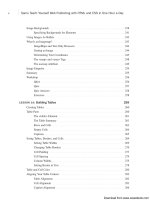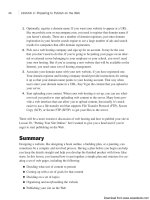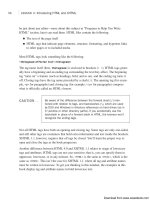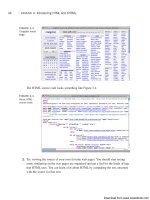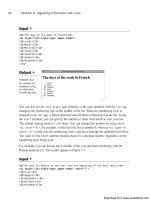Tự học HTML và CSS trong 1 giờ - part 6 pot
Bạn đang xem bản rút gọn của tài liệu. Xem và tải ngay bản đầy đủ của tài liệu tại đây (637.48 KB, 10 trang )
ptg
n
Set the goals for the website.
n
Organize your content into the main topics.
n
Come up with a general structure for pages and topics.
n
Use storyboarding to plan your website.
Anatomy of a Website
First, here’s a look at some simple terminology I use throughout this book. You need to
know what the following terms mean and how they apply to the body of work you’re
developing for the Web:
n
Website—A collection of one or more web pages linked together in a meaningful
way that, as a whole, describes a body of information or creates an overall effect
(see Figure 2.1).
n
Web server—A computer on the Internet or an intranet that delivers web pages
and other files in response to browser requests. (An intranet is a network that uses
Internet protocols but is not publicly accessible.)
n
Web page—A single document on a website, usually consisting of an Hypertext
Markup Language (HTML) document and any items that are displayed within that
document, such as inline images.
n
Home page—The entry page for a website, which can link to additional pages on
the same website or pages on other sites.
Each website is stored on a web server. Throughout the first few lessons in this book,
you learn how to develop well thought-out and well-designed websites. Later, you learn
how to publish your site on an actual web server.
A web page is an individual element of a website in the same way that a page is a single
element of a book or a newspaper. (Although, unlike paper pages, web pages can be of
any length.) Web pages sometimes are called web documents. Both terms refer to the
same thing. A web page consists of an HTML document and all the other components
that are included on the page, such as images or other media.
One problem with the term home page is that it means different things in different con-
texts. If you’re browsing the Web, you usually can think of the home page as the web
page that loads when you start your browser or when you click the Home button. Each
browser has its own default home page, which generally leads to the website of the
browser’s creator or one that makes it some money through advertising when you visit.
26
LESSON 2: Preparing to Publish on the Web
Download from www.wowebook.com
ptg
FIGURE 2.1
Websites and
pages.
Anatomy of a Website
27
2
Pages within the
website
The website
this ios asd
this aiasd dd
kiwlwototdfsdd
sddsd lfl ff dgj
this ios asd
this aiasd dd
kiwlwototdfsdd
Within your browser, you can change that default home page to point to any page you
want. Many users create a personalized page linking to sites they use often and set that as
their browser’s home page.
If you’re publishing pages on the Web, however, the term home page has an entirely dif-
ferent meaning. The home page is the first or topmost page on your website. It’s the
intended entry point that provides access to the rest of the pages you’ve created (see
Figure 2.2).
Most of your users will access your site through your home page,
but some will enter your site through other pages. The nature of
the Web is that people can link to any page on your site. If you
have interesting information on a page other than your home
page, people will link directly to that page. On the other pages of
your site, you shouldn’t assume that the visitor has seen your
home page.
A home page usually contains an overview of the content of the website, available from
that starting point—for example, in the form of a table of contents or a set of icons. If
your content is small enough, you might include everything on that single home page—
making your home page and your website the same thing. A personal home page might
include a link to a person’s resumé and some pictures from a recent vacation. A corpo-
rate home page usually describes what the company does and contains links like “About
the Company,” “Products and Services,” and “Customer Support.”
CAUTION
Download from www.wowebook.com
ptg
FIGURE 2.2
A home page.
28
LESSON 2: Preparing to Publish on the Web
The home page
this ios asd
this aiasd dd
kiwlwototdfsdd
sddsd lfl ff dgj
this ios asd
this aiasd dd
kiwlwototdfsdd
What Do You Want to Do on the Web?
This question might seem silly. You wouldn’t have bought this book if you didn’t already
have some idea of what you want to put online. But maybe you don’t really know what
you want to put on the Web, or you have a vague idea but nothing concrete. Maybe it has
suddenly become your job to work on the company website, and someone handed you
this book and said, “Here, this will help.” Maybe you just want to do something similar
to some other web page you’ve seen and thought was particularly cool.
What you want to put on the Web is what I refer to throughout this book as your content.
Content is a general term that can refer to text, graphics, media, interactive forms, and so
on. If you tell someone what your web pages are about, you’re describing your content.
What sort of content can you put on the Web? Just about anything you want to. Here are
some of the types of content that are popular on the Web right now:
n
Stuff for work—Perhaps you work in the accounting department and you need to
publish the procedure for filing expense reports on your company’s intranet. Or
you’re a software developer and you need to publish the test plan for your com-
pany’s next software release on an internal web server. Chances are that you can
publish some information on a web page at work that will save you from having to
type it into an email every time someone asks you about it. Try it!
n
Personal information—You can create pages describing everything anyone could
ever want to know about you and how incredibly marvelous you are—your hob-
bies, your resumé, your picture, things you’ve done.
n
Blogs and journals—Many people publish their journals or their opinions on a
blog. Many people use content management applications to publish their journals
or blogs, but knowing HTML is still helpful for changing the look and feel of your
site and sprucing up your individual entries or articles.
Download from www.wowebook.com
ptg
n
Hobbies or special interests—A web page can contain information about a partic-
ular topic, hobby, or something you’re interested in; for example, music, Star Trek,
motorcycles, cult movies, hallucinogenic mushrooms, antique ink bottles, or
upcoming jazz concerts in your city.
n
Publications—Newspapers, magazines, and other publications lend themselves
particularly well to the Web, and websites have the advantage of being more imme-
diate and easier to update than their print counterparts. Delivery is a lot simpler,
too. The same holds true for a newsletter for your garden club or news about your
neighborhood association.
n
Company profiles—You could offer information about what a company does,
where it’s located, job openings, data sheets, whitepapers, marketing collateral,
product demonstrations, and whom to contact.
n
Online documentation—The term online documentation can refer to everything
from quick-reference cards to full reference documentation to interactive tutorials
or training modules. Anything task-oriented (changing the oil in your car, making a
soufflé, creating landscape portraits in oil, learning HTML) could be described as
online documentation.
n
Shopping catalogs—If your company offers items for sale, making your products
available on the Web is a quick and easy way to let your customers know what you
have available and your prices. If prices change, you can just update your web doc-
uments to reflect that new information.
n
Online stores—The Web is a great place to sell things. Various sites let just about
anybody sell stuff online. You can auction your goods off at eBay or sell them for a
fixed price at half.com. Amazon.com lets you do both. You can also create your
own online store if you want. There’s plenty of software out there these days to
make the task of selling things online a lot easier than it used to be.
n
Polling and opinion gathering—Forms on the Web enable you to get feedback
from your visitors via opinion polls, suggestion boxes, comments on your web
pages or your products, or through interactive discussion groups.
n
Online education—The low cost of information delivery to people anywhere with
an Internet connection via the Web makes it an attractive medium for delivery of
distance-learning programs. Already, numerous traditional universities, and new
online schools and universities, have begun offering distance learning on the Web.
For example, the Massachusetts Institute of Technology is placing teaching materi-
als online for public use at />n
Anything else that comes to mind—Hypertext fiction, online toys, media
archives, collaborative art…anything!
What Do You Want to Do on the Web?
29
2
Download from www.wowebook.com
ptg
The only thing that limits what you can publish on the Web is your own imagination. If
what you want to do with it isn’t in this list or seems especially wild or half-baked, that’s
an excellent reason to try it. The most interesting web pages are the ones that stretch the
boundaries of what the Web is supposed to be capable of.
You might also find inspiration in looking at other websites similar to the one you have
in mind. If you’re building a corporate site, look at the sites belonging to your competi-
tors and see what they have to offer. If you’re working on a personal site, visit sites that
you admire and see whether you can find inspiration for building your own site. Decide
what you like about those sites and you want to emulate, and where you can improve on
those sites when you build your own.
If you really have no idea of what to put up on the Web, don’t feel that you have to stop
here; put this book away, and come up with something before continuing. Maybe by
reading through this book, you’ll get some ideas. (And this book will be useful even if
you don’t have ideas.) I’ve personally found that the best way to come up with ideas is to
spend an afternoon browsing on the Web and exploring what other people have done.
Setting Your Goals
What do you want people to accomplish on your website? Are your visitors looking for
specific information on how to do something? Are they going to read through each page
in turn, going on only when they’re done with the page they’re reading? Are they just
going to start at your home page and wander aimlessly around, exploring your world
until they get bored and go somewhere else?
Suppose that you’re creating a website that describes the company where you work.
Some people visiting that website might want to know about job openings. Others might
want to know where the company actually is located. Still others might have heard that
your company makes technical whitepapers available over the Net, and they want to
download the most recent version of a particular paper. Each of these goals is valid, so
you should list each one.
For a shopping catalog website, you might have only a few goals: to enable your visitors
to browse the items you have for sale by name or price, and to order specific items after
they finish browsing.
For a personal or special-interest website, you might have only a single goal: to enable
your visitors to browse and explore the information you provide.
30
LESSON 2: Preparing to Publish on the Web
Download from www.wowebook.com
ptg
The goals do not have to be lofty (“this website will bring about world peace”) or even
make much sense to anyone except you. Still, coming up with goals for your Web docu-
ments prepares you to design, organize, and write your web pages specifically to reach
these goals. Goals also help you resist the urge to obscure your content with extra infor-
mation.
If you’re designing web pages for someone else—for example, if you’re creating the
website for your company or if you’ve been hired as a consultant—having a set of goals
for the site from your employer definitely is one of the most important pieces of informa-
tion you should have before you create a single page. The ideas you have for the website
might not be the ideas that other people have for it, and you might end up doing a lot of
work that has to be thrown away.
Breaking Up Your Content into Main
Topics
With your goals in mind, try to organize your content into main topics or sections,
chunking related information together under a single topic. Sometimes the goals you
came up with in the preceding section and your list of topics will be closely related. For
example, if you’re putting together a web page for a bookstore, the goal of ordering
books fits nicely under a topic called, appropriately, “Ordering Books.”
You don’t have to be exact at this point in development. Your goal here is just to try to
come up with an idea of what, specifically, you’ll be describing in your web pages. You
can organize the information better later, as you write the actual pages.
Suppose that you’re designing a website about how to tune up your car. This example is
simple because tune-ups consist of a concrete set of steps that fit neatly into topic head-
ings. In this example, your topics might include the following:
n
Change the oil and oil filter.
n
Check and adjust engine timing.
n
Check and adjust valve clearances.
n
Check and replace the spark plugs.
n
Check fluid levels, belts, and hoses.
Don’t worry about the order of the steps or how you’re going to get your visitors to go
from one section to another. Just list the points you want to describe in your website.
Breaking Up Your Content into Main Topics
31
2
Download from www.wowebook.com
ptg
How about a less task-oriented example? Suppose that you want to create a set of web
pages about a particular rock band because you’re a big fan, and you’re sure other fans
would benefit from your extensive knowledge. Your topics might be as follows:
n
The history of the band
n
Biographies of each of the band members
n
A discography (all the albums and singles the band has released)
n
Selected lyrics
n
Images of album covers
n
Information about upcoming shows and future albums
You can come up with as many topics as you want, but try to keep each topic reasonably
short. If a single topic seems too large, try to break it up into subtopics. If you have too
many small topics, try to group them together into a more general topic heading. For
example, if you’re creating an online encyclopedia of poisonous plants, having individual
topics for each plant would be overkill. You can just as easily group each plant name
under a letter of the alphabet (A, B, C, and so on) and use each letter as a topic. That’s
assuming, of course, that your visitors will be looking up information in your encyclope-
dia alphabetically. If they want to look up poisonous plants by using some other method,
you’d need to come up with another system of organization, too.
Your goal is to have a set of topics that are roughly the same size and that group together
related bits of information you have to present.
Ideas for Organization and Navigation
At this point, you should have a good idea of what you want to talk about and a list of
topics. The next step is to actually start structuring the information you have into a set
of web pages. Before you do that, however, consider some standard structures that have
been used in other help systems and online tools. This section describes some of these
structures, their various features, and some important considerations, including the
following:
n
The kinds of information that work well for each structure
n
How visitors find their way through the content of each structure type to find what
they need
n
How to make sure that visitors can figure out where they are within your docu-
ments (context) and find their way back to a known position
32
LESSON 2: Preparing to Publish on the Web
Download from www.wowebook.com
ptg
As you read this section, think about how your information might fit into one of these
structures or how you could combine these structures to create a new structure for your
website.
Hierarchies
Probably the easiest and most logical way to structure your web documents is in a hierar-
chical or menu fashion, as illustrated in Figure 2.3. Hierarchies and menus lend them-
selves especially well to online and hypertext documents. Most online help systems, for
example, are hierarchical. You start with a list or menu of major topics; selecting one
leads you to a list of subtopics, which then leads you to a discussion about a particular
topic. Different help systems have different levels, of course, but most follow this simple
structure.
Ideas for Organization and Navigation
33
2
Home
FIGURE 2.3
Hierarchical
organization.
In a hierarchical organization, visitors can easily see their position in the structure. Their
choices are to move up for more general information or down for more specific informa-
tion. If you provide a link back to the top level, your visitors can get back to some
known position quickly and easily.
In hierarchies, the home page provides the most general overview to the content below it.
The home page also defines the main links for the pages farther down in the hierarchy.
For example, a website about gardening might have a home page with the topics shown
in Figure 2.4.
Download from www.wowebook.com
ptg
FIGURE 2.4
A Gardening home
page with a hierar-
chical structure.
34
LESSON 2: Preparing to Publish on the Web
If you select Fruits, you then follow a link “down” to a page about fruits (see Figure 2.5).
From there, you can go back to the home page, or you can select another link and go far-
ther down into more specific information about particular fruits.
FIGURE 2.5
Your hierarchy
takes you to the
Fruits page.
Selecting Soft Fruits takes you to yet another menu-like page, where you have still more
categories from which to choose (see Figure 2.6). From there, you can go up to Fruits,
back to the home page, or down to one of the choices in this menu.
Download from www.wowebook.com
ptg
Note that each level has a consistent interface (up, down, back to index), and that each
level has a limited set of choices for basic navigation. Hierarchies are structured enough
that the chance of getting lost is minimal. This especially is true if you provide clues
about where up is; for example, an Up to Soft Fruits link as opposed to just Up.
In addition, if you organize each level of the hierarchy and avoid overlap between topics
(and the content you have lends itself to a hierarchical organization), using hierarchies
can be an easy way to find particular bits of information. If that use is one of your goals
for your visitors, using a hierarchy might work particularly well.
Avoid including too many levels and too many choices, however, because you can easily
annoy your visitors. Having too many menu pages results in “voicemail syndrome.” After
having to choose from too many menus, visitors might forget what they originally
wanted, and they’re too annoyed to care. Try to keep your hierarchy two to three levels
deep, combining information on the pages at the lowest levels (or endpoints) of the hier-
archy if necessary.
Linear
Another way to organize your documents is to use a linear or sequential organization,
similar to how printed documents are organized. In a linear structure, as illustrated in
Figure 2.7, the home page is the title or introduction, and each page follows sequentially.
In a strict linear structure, links move from one page to another, typically forward and
back. You also might want to include a link to Home that takes the user quickly back to
the first page.
Ideas for Organization and Navigation
35
2
FIGURE 2.6
From the Fruits
page, you can find
the Soft Fruits
page.
Download from www.wowebook.com

